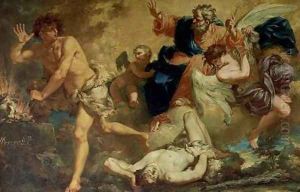Giambattista Mengardi Paintings
Giambattista Mengardi, sometimes also spelled as Giovanni Battista Mengardi, was an 18th-century Venetian painter who worked primarily in the Rococo style, which was prevalent during his time. Born in Venice in 1738, Mengardi was part of a period of art that was characterized by lightness, elegance, and an exuberant use of color. This was a time when Venice was a major center of art and culture in Europe, and his work reflects the rich artistic environment of the city.
Mengardi trained under the guidance of prominent artists of the era, such as Giambattista Tiepolo, who was one of the most famous decorators of the time. Although Mengardi's work is not as widely recognized as that of his master Tiepolo, he did produce a body of work that contributed to the Venetian art scene. Mengardi focused mainly on religious and mythological themes, often painting altarpieces and ceiling frescoes for churches and palaces in Venice and the surrounding region.
His style is characterized by a graceful arrangement of figures and a delicate handling of light and shade, which impart a sense of softness to his paintings. Like many of his contemporaries, Mengardi was influenced by the dynamic compositions and vibrant palette of the Baroque, but he tempered this with a Rococo sense of finesse and charm. His work is noted for its decorative qualities and the sense of movement within the fluid lines and compositions.
Giambattista Mengardi's career unfolded during a period when the art world was transitioning from the grandeur of the Baroque towards the more intricate and ornamental Rococo, and eventually towards Neoclassicism. However, his works remained true to the Rococo style throughout his life, which may have contributed to his relative obscurity compared to artists who adapted to the changing tastes of the time.
Mengardi's contributions to Venetian art were modest relative to the giants of the era, but he still maintained a respectable place within the local art community. He died in Venice in 1796, leaving behind a legacy that, while overshadowed by the more famous names of the period, still offers a glimpse into the vibrancy and richness of Venetian Rococo painting.
